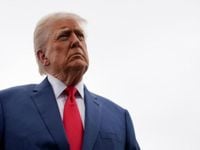In a dramatic shift that’s reverberating across capitals from Washington to Kyiv and Brussels, U.S. President Donald Trump has overhauled his approach to the war in Ukraine, calling Russia a "paper tiger" and throwing his support behind Ukraine’s quest to reclaim all its territories—with a crucial caveat: the heavy lifting, he now insists, must come from Europe. This pivot, signaled in late September 2025 after a high-profile meeting with Ukrainian President Volodymyr Zelenskyy at the United Nations General Assembly in New York, marks a watershed moment in the West’s response to Russia’s ongoing aggression.
According to RBC-Ukraine, the September 23 meeting between Trump and Zelenskyy was anything but routine. Trump, who had previously wavered on the extent of American involvement, emerged from the talks with a striking post on Truth Social: "After getting to know and fully understand the Ukraine/Russia Military and Economic situation and, after seeing the Economic trouble it is causing Russia, I think Ukraine, with the support of the European Union, is in a position to fight and WIN all of Ukraine back in its original form." He added that with patience and financial backing from Europe—including NATO—Ukraine could restore its territorial integrity and even "go further."
This new rhetoric was not lost on Zelenskyy, who confirmed that Trump’s shift was directly influenced by their discussion. The Ukrainian leader told reporters that Trump now supported Kyiv’s right to retaliate against Russian strikes, including those targeting energy infrastructure. "We discussed several promising ideas to bring peace closer, and I hope they will yield swift results," Zelenskyy remarked, hinting at a new phase in U.S.-Ukrainian cooperation.
But Trump’s support comes with strings attached. As Devdiscourse and others report, the president is signaling a retreat from direct U.S. leadership in the conflict, instead urging the European Union to step up. "Europe needs time, patience, and financial support to assist Kyiv in reclaiming its territories," Trump stated, emphasizing that the U.S. would focus on supplying weapons through NATO rather than boots on the ground or open-ended financial commitments. The message was clear: it’s Europe’s turn to lead.
This approach is already having ripple effects. Since Trump’s inauguration for a second term in January 2025, he has pressed European leaders to ramp up military and economic aid to Ukraine. According to the Kiel Institute, by June 30, 2025, Europe had allocated €167.4 billion ($195 billion) in aid to Ukraine, including €80.5 billion ($94 billion) in military support—an amount 1.5 times greater than the U.S. contribution. European leaders are now debating whether to repurpose €300 billion ($350 billion) in frozen Russian assets to fund Ukraine’s war effort and reconstruction. There’s also a proposal on the table to accelerate the phase-out of Russian natural gas imports, moving up the original 2027 deadline.
Yet, as Devdiscourse notes, Europe faces daunting internal challenges. Inflation and public finance pressures complicate efforts to unify defense priorities, and the urgency for defense-industrial cooperation is growing. European officials are scrambling to develop indigenous defense capabilities, aiming to reduce reliance on American support while maintaining regional stability. The stakes are high: Russian provocations, including increased drone incursions into Danish airspace and a sharp uptick in violations of NATO European members’ airspace, are testing the alliance’s resolve.
Trump’s strategy isn’t limited to Europe. He has also leaned on key Russian energy buyers—Hungary, Slovakia, and Turkey—to cut their purchases. During his meeting with Zelenskyy, the Ukrainian president suggested Slovakia might halt Russian energy imports under certain conditions, and Trump pledged to personally urge Hungary’s Prime Minister Viktor Orbán to follow suit. However, Hungary’s Foreign Minister Péter Szijjártó swiftly rebuffed the idea, stating his country would not stop buying Russian oil even at Trump’s request. Trump also dangled the possibility of allowing Turkey to rejoin the F-35 fighter jet production program as leverage to persuade President Erdoğan to reduce Russian energy imports.
Meanwhile, the Kremlin’s response has been both dismissive and defiant. Putin’s spokesman Dmitry Peskov rejected Trump’s "paper tiger" label, insisting that Russia is "not a tiger" but rather a bear—"and there are no paper bears." He attributed Trump’s new tone to his meeting with Zelenskyy, while Russian military aircraft increased their incursions into NATO airspace. On the diplomatic front, U.S. Secretary of State Marco Rubio met with Russian Foreign Minister Sergey Lavrov at the U.N., reiterating Trump’s call for an end to the violence and presenting Moscow with a set of conditions for a durable resolution.
Western media have offered varied interpretations of Trump’s pivot. The Wall Street Journal suggests that senior administration officials, advocating for a tougher line on Ukraine, presented Trump with stark battlefield realities—namely, Russia’s limited progress and the need for American support for an upcoming Ukrainian counteroffensive. The Telegraph and Reuters both highlight that Trump’s latest statements seem to shift responsibility for Ukraine’s fate to Europe and NATO, signaling a possible U.S. disengagement. A Western European official told Reuters, "He seems to be saying his goodbyes, no? But that can change tomorrow. In any case, the cards are clear for us. We know what we should be doing."
Yet, others see Trump’s rhetoric as part of a calculated negotiating tactic. According to the New York Post, his insistence that Ukraine can reclaim all occupied territories is designed to pressure Moscow into talks, rather than reflect an actual shift in U.S. policy. White House sources note that while restrictions on U.S. arms sales to Ukraine have been lifted—a positive signal for Kyiv—these are words, not yet concrete actions. As before, Trump’s approach could change with a single phone call to Moscow.
Complicating the picture are the broader economic and geopolitical dynamics. Trump has imposed tariffs ranging from 50% to 100% on select Chinese imports and raised tariffs on Indian goods to 50%, aiming to squeeze Russia’s key economic allies. Still, China and India remain Russia’s largest trading partners, accounting for 45% of its fossil fuel exports since February 2022. The U.S. itself relies on China for critical raw materials and is deeply entwined with global supply chains—an inconvenient truth for any strategy seeking to isolate Moscow.
On the ground, Ukraine’s resolve remains formidable, with Zelenskyy articulating a vision of full territorial recovery, including Crimea and the Donbas. Yet, rising casualties have led 69% of Ukrainians to favor a negotiated end to the war as soon as possible, according to a July 2025 Gallup survey. Meanwhile, American public opinion is increasingly focused on domestic issues like inflation and jobs, with only 3.8% citing foreign policy as a top concern. Still, 62% of Americans support providing more arms to Ukraine, according to the Chicago Council on Global Affairs.
Trump’s evolving stance has energized Ukraine and its Western allies, potentially reshaping the future of transatlantic security, global energy markets, and Western deterrence. But as the dust settles on this latest rhetorical shift, one thing is certain: ending the war will demand not just words or symbolic gestures, but sustained American commitment and robust international coordination. The stakes—for Ukraine, for Europe, and for the world—could hardly be higher.

